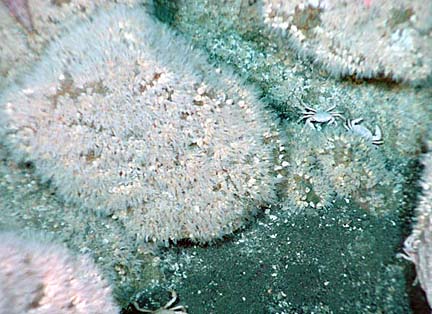
|
Underwater wealth
Some discoveries may have
industrial and medical uses
Long-necked barnacles and other strange critters, microorganisms with potential use for new drugs, and large sulfide chimneys are among the discoveries of a South Pacific expedition by an international team of scientists, including some from the University of Hawaii.
The five-month expedition "has been very, very successful so far. We're extremely pleased," said John Wiltshire, acting director of the Hawaii Undersea Research Laboratory. "They found an incredible wealth of underwater species, many of which we anticipate will be new species."
HURL's three-person submersibles Pisces IV and Pisces V left Honolulu on March 18 with their mother ship, Ka'imikai-O-Kanaloa, on the "New Zealand American Submarine Ring of Fire Expedition," working their way to New Zealand to study undersea volcanoes, fisheries and marine life.
Wiltshire said that UH microbial researchers and University of Mississippi pharmacology scientists will study the discovered microorganisms for possible industrial and pharmaceutical uses.
After two weeks in dry-dock in Auckland, New Zealand, the submersibles are en route to Tonga and American Samoa for another series of dives on undersea volcanoes.

|
In a telephone interview from New Zealand late last week, expedition organizer Alex Malahoff said the submersibles visited nine submarine volcanoes on 22 dives on the New Zealand leg of the trip.
"I had the honor of the first dives on two volcanoes no one had been down on before," he said. These are Clark and Tangaroa volcanoes, part of the Kermadec volcano chain.
"What's really startling about these, compared to Loihi (seamount off the Big Island), is the incredible concentration and diversity of life," he said.
He said the most surprising thing was "the tremendous concentration of long-necked barnacles that have taken over the landscape" on Clark volcano. "They're up to 18 inches high."
The scientists also discovered two large sulfide chimneys on Clark, which they dubbed the "Two Towers," built of sulfides and sulfates. The water temperature was nearly 500 degrees Fahrenheit, Malahoff said.
He said the chimneys are nearly 30 feet high. "They looked like they were out of 'Lord of the Rings.' Metal deposits being formed there are very similar to processes we saw on Loihi.

|
"The startling thing was native yellow sulfur oozing out of volcanoes like toothpaste."
The oceanographers saw orange roughy fish in their native habitat on the seamounts at about 2,640 feet deep for the first time, he said. "Because it's so deep, nobody ever observed them in their own environment. They are wonderful fish, red in color. They really contrast against the ocean floor."
Malahoff, chief executive of the Institute of Geological and Nuclear Sciences Ltd., in Wellington, New Zealand, was instrumental in organizing American, New Zealand and German scientists for the longest expedition by HURL. He is on sabbatical leave from the University of Hawaii and his position as director of HURL, which was established by the National Oceanic and Atmospheric Administration and the University of Hawaii.
Wiltshire said the international team made dives on about 10 volcanoes of the Kermadec arc, including Brothers and Monowai volcanoes. "Each of these volcanoes is kind of a unique environment," he said.
Some are shallow and one is popping above water to become an island, he said. Others are deep and large, perhaps more than 10 miles across, he said.

|
The volcanic region is much more active than the researchers expected, he said. Mussels are crammed against each other, fighting for space in some of the high-temperature vents, "what we think would be a deeply unpleasant place to live," he said.
The mother ship is expected to reach American Samoa June 29 for explorations of Vailuluu, an underwater volcano growing on Samoa's hotspot similar to Loihi on Hawaii's hotspot.
Scientists from Germany's University of Kiel and the Scripps Institution of Oceanography in California are among participants in the expedition's final leg.
Malahoff said it "is sort of a Darwinian leg" with geologists, microbiologists and chemists. "The area is so difficult to get to and so far away, we just wanted to pack as much science as we could."
Terry Kerby, HURL operations director and chief pilot, is operating the subs with pilot Max Cremer and pilots-in-training Steve Price and Colin Wolleman.
www.soest.hawaii.edu/HURL
E-mail to City Desk
[News] [Business] [Features] [Sports] [Editorial] [Do It Electric!]
[Classified Ads] [Search] [Subscribe] [Info] [Letter to Editor]
[Feedback]
